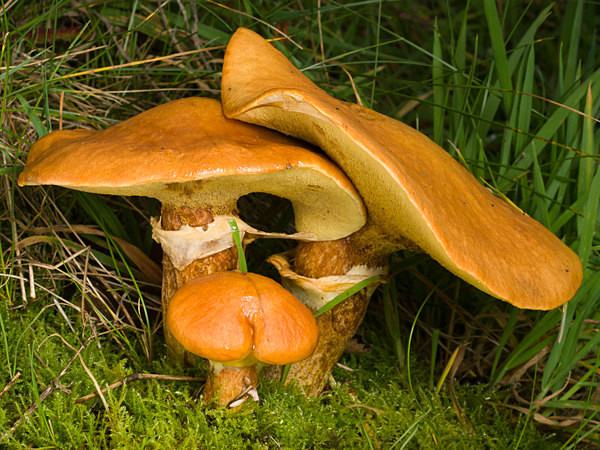Larch Bolete: Red Data Book of Armenia

Category. EN – Endangered.
Brief description. Cap is from 3–14 cm across, brownish, brick– coloured, yellowish–lemon coloured or rusty. It is pulvinate, then flat, with wide hillock, mucous with remnants of volva which reaches up to the double ring. Internal part of the ring is mucous and the surface is pruinose and thick. Flesh is pale yellow in the cap, lemon–orange in the stipe, with pleasant mushroom smell and taste. Tubes are narrow, yellowish, when touched turn ash–grey. Stipe is 6–10 x 1,5–3 cm high, yellow. The upper part of the ring is white, the lower part is brown, punctate. Spore print is yellow–brown. Spores are 7,5–10 x 3–4 µm, ellipsoidal, smooth.
Distribution. Generally in Europe, Asia, Northern America, Southern Caucasus (Armenia). It is widely spread in most European countries, but in Armenia it is rarely found. It is discovered in Lori floristic region – in the territory of “Pine of Gyulagarak” State Sanctuary.
Ecological, biological and phytocenological peculiarities. In Armenia it can be found seldom, on the soil, in coniferous forests, on the altitude of 1200–1400 m above sea level, in August. Mycorrhizal fungi, mainly with larch tree. It is delicious, edible mushroom.
Main factors of endangering. Limited distribution, reduction of wood areas caused by uncontrolled felling. Irregular mushroom gathering by the population.
Nature conservation measures. It is conserved in corresponding ecosystems of "Pine of Gyulagarak" State Sanctuary. It is necessary to forbid mushroom gathering.
Suggestions
 The Ministry of Environment sent a letter international partners to draw their attention to the real danger of environmental disasters as a result of Azerbaijan's large-scale aggression towards the territory of Armenia
The Ministry of Environment sent a letter international partners to draw their attention to the real danger of environmental disasters as a result of Azerbaijan's large-scale aggression towards the territory of Armenia
 Vicia pisiformis: Red Data Book of Armenia
Vicia pisiformis: Red Data Book of Armenia
 Vavilovia formosa: Red Data Book of Armenia
Vavilovia formosa: Red Data Book of Armenia
 Trigonella capitata: Red Data Book of Armenia
Trigonella capitata: Red Data Book of Armenia
 Trigonella astroides: Red Data Book of Armenia
Trigonella astroides: Red Data Book of Armenia












